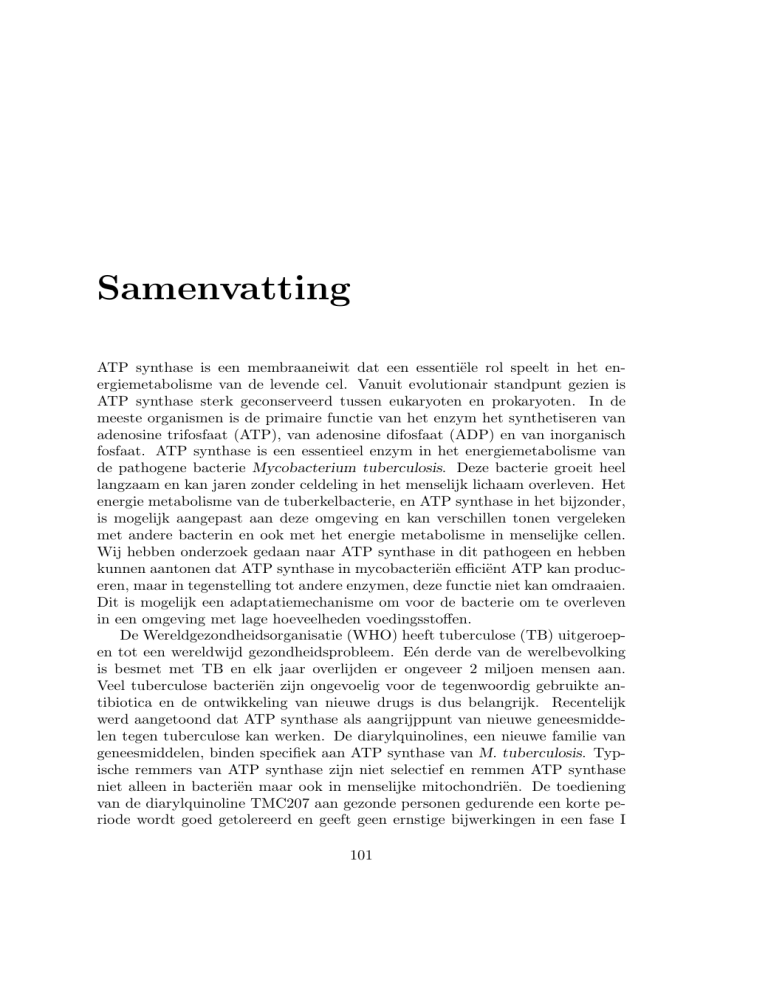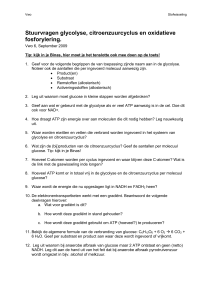
Samenvatting
ATP synthase is een membraaneiwit dat een essentiële rol speelt in het energiemetabolisme van de levende cel. Vanuit evolutionair standpunt gezien is
ATP synthase sterk geconserveerd tussen eukaryoten en prokaryoten. In de
meeste organismen is de primaire functie van het enzym het synthetiseren van
adenosine trifosfaat (ATP), van adenosine difosfaat (ADP) en van inorganisch
fosfaat. ATP synthase is een essentieel enzym in het energiemetabolisme van
de pathogene bacterie Mycobacterium tuberculosis. Deze bacterie groeit heel
langzaam en kan jaren zonder celdeling in het menselijk lichaam overleven. Het
energie metabolisme van de tuberkelbacterie, en ATP synthase in het bijzonder,
is mogelijk aangepast aan deze omgeving en kan verschillen tonen vergeleken
met andere bacterin en ook met het energie metabolisme in menselijke cellen.
Wij hebben onderzoek gedaan naar ATP synthase in dit pathogeen en hebben
kunnen aantonen dat ATP synthase in mycobacteriën efficiënt ATP kan produceren, maar in tegenstelling tot andere enzymen, deze functie niet kan omdraaien.
Dit is mogelijk een adaptatiemechanisme om voor de bacterie om te overleven
in een omgeving met lage hoeveelheden voedingsstoffen.
De Wereldgezondheidsorganisatie (WHO) heeft tuberculose (TB) uitgeroepen tot een wereldwijd gezondheidsprobleem. Eén derde van de werelbevolking
is besmet met TB en elk jaar overlijden er ongeveer 2 miljoen mensen aan.
Veel tuberculose bacteriën zijn ongevoelig voor de tegenwoordig gebruikte antibiotica en de ontwikkeling van nieuwe drugs is dus belangrijk. Recentelijk
werd aangetoond dat ATP synthase als aangrijppunt van nieuwe geneesmiddelen tegen tuberculose kan werken. De diarylquinolines, een nieuwe familie van
geneesmiddelen, binden specifiek aan ATP synthase van M. tuberculosis. Typische remmers van ATP synthase zijn niet selectief en remmen ATP synthase
niet alleen in bacteriën maar ook in menselijke mitochondriën. De toediening
van de diarylquinoline TMC207 aan gezonde personen gedurende een korte periode wordt goed getolereerd en geeft geen ernstige bijwerkingen in een fase I
101
102
Samenvatting
klinische studie. We hebben kunnen aantonen dat mycobacterieel ATP synthase
meer dan 20.000 keer gevoeliger is dan menselijke ATP synthase voor TMC207.
Het is daardoor onwaarschijnlijk dat TMC207 toxisch zal zijn voor cellen van
zoogdieren. Wij hebben ook het bindingsmechanisme van TCM207 en ATP
synthase onderzocht, de resultaten geven support aan een mechanisme dat door
computer analyses voorspeld werd. De drug bindt onafhankelijk van omgevingsfactoren zoals de pH waarde of de hoeveelheid beschikbare energie, een belangrijke eigenschap voor tuberculose drugs. Een proteom analyse verhelderde
het metabolische respons van de bacteriën op toediening van het antibioticum,
deze resultaten kunnen helpen bij het vinden van “zwakke punten” van de tuberkelbacterie. De beschikbaarheid van geı̈soleerd mycobacterieel ATP synthase
zou van nut kunnen zijn om de binding tussen TMC207 en ATP synthase te
onderzoeken. Daarnaast zou het geı̈soleerde ATP synthase informatie kunnen
verschaffen over de ongewoonlijke subunit compositie van het eiwit.
De experimenten en resultaten van dit proefschrift kunnen een belangrijke
bijdrage leveren aan zowel fundamenteel begrip van energie metabolisme en
ATP synthese in pathogene bacteriën als ook aan de ontwikkeling van nieuwe
geneesmiddelen die energieomzet in tuberkelbacterië remmen.
Acknowledgements
Many people have contributed to and supported me during the research presented in this thesis. I would like to thank my supervisor Dirk for giving me
the opportunity to do my PhD in your research group. You always gave me
a lot of input, feedback and support during the past four years. The work at
the VU University would not have been possible without the support from my
colleagues form the section Structural Biology. I would like to thank Holger, Petra, Henk, Zorica, Froukje, Selena, Ovidiu, Lu, Yves, Joost, Annelies, Marijke,
Rieky and all other group members and students of the section. Holger thank
you for being my promotor and for giving me feed-back on the chapters in my
thesis. Petra you were a great support and we had much fun during and outside
working hours. Selena, Froukje and Annelies thank you for the cheerful lunches
and the talks about life in general. During my PhD I had the opportunity to
supervise a couple of bachelor and master students. Guido, Sandra, Rooda,
Benjamin, Froukje, Marc-Manuel, Ioana, Bart, Han and Wai-Lung thank you
all for your contributions, some were very useful for writing parts of this thesis.
Marijke Wagner and dr. Klaas Krab of the section Molecular Cell Physiology,
thank you for helping me with setting up and analyzing the oxygen electrode
experiments. Dr. Nicole Driessen and dr. Ben Appelmelk of the Department
of Medical Microbiology and Infection Control, VU university medical center,
thank you for sharing your facilities in your laboratory and helping me setting
up the culturing of the mycobacteria.
Dr. Ansgar Poetsch, dr. Ute Haußmann and Carina Ramallo of the Lehrstuhl Biochemie der Pflanzen at the Ruhr-Universität Bochum, thank you for
measuring and analyzing the samples and learning me the basics of massspectrometry. It was always a pleasant stay and an educational experience
in Bochum.
Prof. dr. W. Bitter, prof. dr. M.J. Smit, prof. dr. D. van Soolingen, dr.
R. Anthony, dr. A. Koul and dr. N. Dhar, thank you for critically reading this
103
104
Acknowledgements
thesis and providing useful feed-back.
Leave Heit en Mem, der binne hiel wat jieren foarby gien werby ik my fan
it iene yn it oare aventoer stoarten haw. Stúdzje, stage yn sawol Nederlân as
it bûtenlân, promovere en folle ferhúzingen, mar jim hawwe my al dy jieren
bystien en folle leafde jûn. Sûnder jim hie ik it net helle.
Maria, Jeltsen en Nienke, jullie zijn altijd direct en indirect een grote steun
geweest.
Curriculum Vitae
Work Experience
Research technician
July 2011 - present
Joo lab: Single Molecule Fluorescence.
&
Abbondanzieri lab: HIV reverse transcriptase
& DNA-binding proteins from starved cells
Department of Bionanoscience, Kavli Institute of NanoScience, Delft University
of Technology.
PhD student
September 2006 - December 2010
Group of Dirk Bald, Section Structural Biology, Department of Molecular Cell
Biology, Faculty of Earth and Life Sciences, VU University Amsterdam.
Student assistant
Course on Infectious Diseases, VU University Amsterdam.
2005
Education
M.Sc.
September 2004 - July 2007
Biomolecular Sciences, specialization Cell Biology, VU University Amsterdam,
The Netherlands.
B.Sc.
August 1999 - July 2004
Clinical Chemistry, Hoger Laboratorium Onderwijs, Saxion Hogeschool, Enschede, The Netherlands.
105
106
Curriculum Vitae
Publications
Lu, P. Haagsma, A.C., Pham, H., Maaskant, J.J., Mol, S., Lill, H. & Bald,
D. (2011). Pyrazinoic acid decreases the proton motive force, respiratory ATP
synthesis activity, and cellular ATP levels. Antimicrob. Agents Chemother. 55:
5354-5357.
Haagsma, A.C., Podasca, I., Koul, A., Andries, K., Guillemont, J.E.G., Lill,
H. & Bald, D. (2011). Probing the interaction of the diarylquinoline TMC207
with its target mycobacterial ATP synthase. PloS ONE 6: e23575.
Haagsma, A.C., Driessen, N.N., Hahn, M.-M., Lill, H. & Bald, D. (2010).
ATP synthase in slow- and fast-growing mycobacteria is active in ATP synthesis
and blocked in ATP hydrolysis direction. FEMS Microbiol. Lett. 313: 68-74.
Haagsma, A.C., Abdillahi-Ibrahim, R., Wagner, M.J., Krab, K., Vergauwen,
K., Guillemont, J.E.G., Andries, K., Lill, H., Koul, A. & Bald, D. (2009).
Selectivity of TMC207 towards mycobacterial ATP synthase compared with
that towards the eukaryotic homologue. Antimicrob. Agents Chemother. 53:
1290-1292
Ismail, N. Crawshaw, S.G. Cross, B.C. Haagsma, A.C. & High, S. (2008).
Specific transmembrane segments are selectively delayed at the ER translocon
during opsin biogenesis. Biochem. J. 1: 495-506
Conferences
Poster presentation at the spring meeting of the two Dutch Microbiological
Societies (NVMM & NVvM) 2010 (Arnhem, The Netherlands)
Poster presentation at Annual Meeting of the NWO-CW study groups Protein
Research, Nucleic acids, Lipids & Biomembranes 2010 (Veldhoven, The Netherlands)
Oral presentation at Annual Meeting of the NWO-CW study groups Protein
Research, Nucleic acids, Lipids & Biomembranes 2009 (Veldhoven, The Netherlands)
Poster presentation at FEMS congress of European Microbiologists 2009 (Gothenburg, Sweden)
Poster presentation at Annual Conference of the Association for General and
Applied Microbiology (VAAM) 2009 (Bochum, Germany)
107
Poster presentation at Annual Meeting of the NWO-CW study groups Protein
Research, Nucleic acids, Lipids & Biomembranes 2008 (Veldhoven, The Netherlands)
Poster presentation at Joint Annual Conference of the Association for General
and Applied Microbiology (VAAM) and the German Society for Biochemistry
and Molecular Microbiology (GBM) 2008 (Frankfurt, Germany)
Poster presentation at Annual Meeting of the NWO-CW Lipids and Biomembranes 2007 (Lunteren, The Netherlands)












